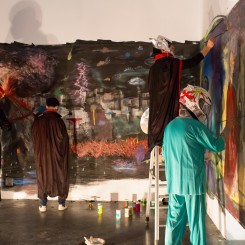“SEE/SAW” is the current exhibition series at UCCA examining artists’ collectives at work in China now. The series features — in collaborative guise — many of those who will participate in “ON|OFF: China’s Young Artists in Concept and Practice,” which will open in early 2013. Every week for six weeks, there will be a new installation in the Long Gallery showcasing the work of two or three collectives, of which there are fourteen in total. Now in its third week, the series has allowed artists to work actively in the space and to intervene in the exhibitions as they unfold. The series is designed not only to introduce the work of these groups to audiences in Beijing, but also to bring them into contact with each other and with an institution (an environment wherein one would not usually encounter this kind of work) to see what this might bring about.
Randian met curator Paula Tsai to talk about “SEE/SAW.”
Iona Whittaker: How does the installation work? It must be a very quick process.
Paula Tsai: The format is 6 weeks and 14 collectives, with a new show every week. On Sunday night after we close we start taking down the previous week’s exhibitions, then we start fixing the walls etc., and then Monday is the day people usually move in and start installing the next show. But it works because the nature of some of these collectives is more performative — they don’t really do much on-site, like both of this week’s participants 8mg and Irrelevant Commission.
IW: How long have you been working on this exhibition project?
PT: Since August. This show came about because I went on a couple of research trips with Bao Dong and Sun Dongdong for our forthcoming “ON | OFF” exhibition; the idea was further developed during the ICI Curatorial Intensive session at UCCA. I met these collectives for the first time and thought, “Wow, I like what they’re doing.” I wanted to do a show, because I think that how collectives practice is so interesting — in particular their relationship with institutions, because we have a different structure.
IW: In what sense?
PT: Well, we have never really worked with an experimental format such as changing the show every week and letting the artists push the rules inside the museum.
IW: That’s what’s nice about it.
PT: Usually our process is that we work with an artist for months, incubating a final proposal, and then it’s so refined, so beautifully executed — which is great, and that’s how an institution should function, but then one also thinks about other possibilities for working.
IW: And you have that nice space aside from the main hall…
PT: Yes, and it’s good to do this because we are presenting these collective voices and saying “We recognise you, and we know you’re there.” I think that’s important.
IW: But there aren’t going to be any collectives in “ON | OFF,” only individual artists?
PT: No, but many of those individual artists are in collectives, so it’s a nice lead-up, seeing their collective practice first and then their individual practice.
IW: So how many of the artists in “ON | OFF” are also involved in collectives, roughly?
PT: There’s a good 20%.
IW: It really seems as if collectives are on the up at the moment.
PT: That’s definitely the trend, or the hash tag at the moment.
IW: Why now, do you think?
PT: I think it’s something that’s particular to this generation. You’ve always had collectives, but more so now just because a lot of them come out of the academic system; they’re all in studios together — Double Fly, for example, are all classmates who got together because they wanted to continue working together and hanging out after they graduated. This is very much in the spirit of that generation. Then you have ones like Guest. They didn’t go to school together but they met and then decided to come together. For a lot of them it’s about the sharing of information — they all have an abundance of information coming to them every day, and it’s much quicker and more efficient to process it within a group. What they contribute to the group and what they take away from it is significant.



